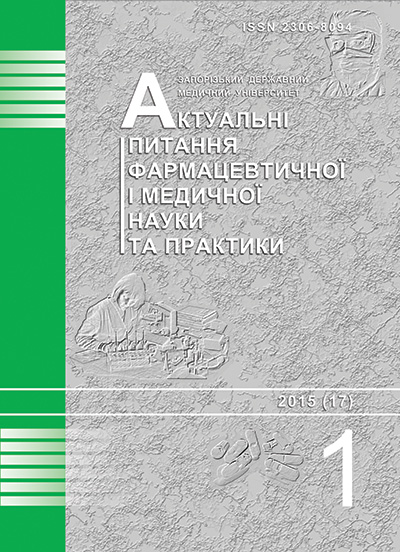Pathohistological and immunohistochemical features of chronic viral hepatitis b progression
DOI:
https://doi.org/10.14739/2409-2932.2015.1.41700Keywords:
Hepatitis B, Chronic Liver Stellate Cells, FibroblastsAbstract
Aim. The paper contains the results of a comprehensive study of pathohistological and immunohistochemical liver biopsies of 50 patients with chronic hepatitis B in relation to clinical and biochemical parameters to improve the most significant microscopic criteria of chronic hepatitis B progression in liver trepanobioptates of the patients.
Methods and results. It has been established that most accurate definition of the degree of viral infection of hepatocytes in the liver trepanobioptates of the patients with chronic viral hepatitis B could be made by the immunohistochemical detection of HBsAg and HBsAg, "dull glasslike" hepatocytes revealed by microscopy not fully reflect the degree of hepatocytes’ infection.
Conclusion. The presence of direct, high correlation between the number of infected hepatocytes with HBsAg and histological hepatitis activity index gives reason to use immunohistochemical labelling of HBsAg on the early stages of diagnostics in order to predict the possible progression of chronic viral hepatitis B in patients with normal level of transaminase.
References
(2012). Hepatitis B. Encyclopedia of Exercise Medicine in Health and Disease. F.C. Mooren (Eds). Berlin; Heidelberg: Springer.
Wursthorn, K. (2014) Hepatitis B. Springer Reference Innere Medizin, 1–8.
Chang, M.-H. (2014). Prevention of Hepatitis B Virus Infection and Liver Cancer. Recent Results Cancer Res., 193, 75–95. doi: 10.1007/978-3-642-38965-8_5.
Wu, Yichen, Wan, Zhihong, You, Shaoli, & Xin, Shaojie (2014). Usefulness of serum T3, and TSH as prognostic indicators for patients of acute-on-chronic liver failure with hepatitis B virus infection. Hepatology International, 8(1), 3. Brisbane, Australia.
Zeng, L. Y., Lian, J. S., Chen, J. Y., Jia, H. Y., Zhang, Y. M., Xiang, D. R., et al. (2014). Hepatitis B surface antigen (HBsAg) levels during the natural history of chronic hepatitis B (CHB): a Chinese perspective study. Hepatology International, 8(1), 32. Brisbane, Australia.
Akbar, S. M., Chen, S., Al-Mahtab, M., & Hiasa, Y. (2014). Comparative immune modulatory capacities of HBsAg, HBcAg, and HBsAg/HBcAg and their utility for development of therapeutic vaccines. Hepatology International, 8(1), 32. Brisbane, Australia.
Knodell, R. G., Ishak, K. G., Black, W. C., Chen, T. S., Craig, R., Kaplowitz, N., et al. (1981). Formulation and application of numerical scoring system for assessing histological activity in asymptomatic chronic active hepatitis. Hepatology, 1, 431–435. doi: 10.1002/hep.1840010511.
(1994). Intraobserver and interobserver variations in liver biopsy interpretation in patients with chronic hepatitis C. Hepatology, 20, 15–20.
Rebrova, O. Yu. (2002). Statisticheskij analiz medicinskikh dannykh. Primenenie paketa prikladnykh programm STATISTICA [Statistical analysis of medical data. Application software package STATISTICA]. Moscow: Media Sfera. [in Russian].
Lapach, S. N., Chubenko, A. V., Babich, P. N. (2001). Statisticheskie metody v mediko-biologicheskikh issledovaniyakh s ispol'zovaniem Excel [Statistical methods in biomedical research using Excel]. Kyiv: Morion. [in Ukrainian].
Downloads
How to Cite
Issue
Section
License
Authors who publish with this journal agree to the following terms:
- Authors retain copyright and grant the journal right of first publication with the work simultaneously licensed under a Creative Commons Attribution License that allows others to share the work with an acknowledgement of the work's authorship and initial publication in this journal.

- Authors are able to enter into separate, additional contractual arrangements for the non-exclusive distribution of the journal's published version of the work (e.g., post it to an institutional repository or publish it in a book), with an acknowledgement of its initial publication in this journal.
- Authors are permitted and encouraged to post their work online (e.g., in institutional repositories or on their website) prior to and during the submission process, as it can lead to productive exchanges, as well as earlier and greater citation of published work (See The Effect of Open Access)

